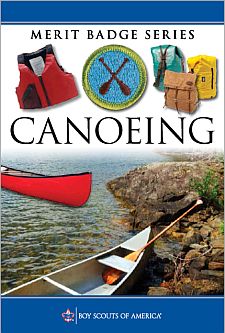- Show that you know first aid for injuries or illnesses that could occur while canoeing, including hypothermia, heat reactions, dehydration, insect stings, tick bites, and blisters.
- Do the following:
- Identify the conditions that must exist before performing CPR on a person. Explain how such conditions are recognized.
- Demonstrate the proper technique for performing CPR using a training device approved by your counselor.
- Before doing the following requirements, successfully complete the BSA swimmer test: Jump feetfirst into water over the head in depth. Level off and swim 75 yards in a strong manner using one or more of the following strokes: sidestroke, breaststroke, trudgen, or crawl; then swim 25 yards using an easy, resting backstroke. The 100 yards must be completed in one swim without stops and must include at least one sharp turn. After completing the swim, rest by floating.
- Discuss the following:
- The BSA Safety Afloat policy. Tell how it applies to canoeing activities.
- The most common weather and water-related hazards encountered while canoeing and how to deal safely with each one.
- Do the following:
- Name and point out the major parts of a canoe.
- Describe how the length and shape of a canoe affect its performance.
- Discuss the advantages and disadvantages of the different materials used to make canoes.
- Name and point out the parts of a paddle. Explain the difference between a straight and bent-shaft paddle and when each is best used.
- Demonstrate how to correctly size a paddle for a paddler in a sitting position and a kneeling position.
- Name the different types of personal flotation devices (PFDs), and explain when each type should be used.
- Show how to properly fit and test a PFD of correct size.
- Discuss the general care and maintenance of canoeing equipment.
- Discuss what personal and group equipment would be appropriate for a canoe camping trip. Describe how personal and group equipment can be packed and protected from water.
- Demonstrate how to load and secure equipment in a canoe.
- Using appropriate knots, demonstrate how to secure a canoe to a rack on land, a vehicle, or a canoe trailer.
- With a companion, wearing the proper PFD and appropriately dressed
for the weather and water conditions, use a properly equipped canoe
to demonstrate the following:
- Safely carry and launch the canoe from a dock or shore (both, if possible).
- Safely land the canoe on a dock or shore (both, if possible) and return it to its proper storage location.
- Demonstrate kneeling and sitting positions in a canoe and explain the proper use for each position.
- Change places while afloat in the canoe.
- In deep water, exit the canoe and get back in without capsizing.
- Capsize the canoe and demonstrate how staying with a capsized canoe will support both paddlers.
- Swim, tow, or push a swamped canoe 50 feet to shallow water. In the shallow water, empty the swamped canoe and reenter it.
- In deep water, rescue a swamped canoe and its paddlers by emptying the swamped canoe and helping the paddlers safely reenter their boat without capsizing.
- With a companion, wearing the proper PFD and appropriately dressed
for the weather and water conditions, demonstrate the following paddling
strokes as both a bow and stern paddler:
- Forward stroke
- Backstroke
- Draw
- Pushaway
- Forward sweep
- Reverse or back sweep
For stern paddling only: - J-stroke
- Using the strokes in requirement 7, demonstrate the following tandem
maneuvers while paddling on opposite sides and without changing sides.
Repeat after switching positions and paddling sides:
- Pivot or spin the canoe in either direction.
- Move the canoe sideways or abeam in either direction.
- Stop the canoe.
- Move the canoe in a straight line for 50 yards.
- Wearing the proper PFD and appropriately dressed for the weather
and water conditions, demonstrate solo canoe handling:
- Launch from shore or a pier (both, if possible).
- Using a single-blade paddle and paddling only on one side, demonstrate proper form and use of the forward stroke, backstroke, draw stroke, pushaway stroke, forward sweep, reverse or back sweep, and J-stroke. Repeat while paddling on the other side.
- While paddling on one side only, paddle a 50-yard course making at least one turn underway and one reverse of direction Repeat while paddling on the other side.
- Make a proper landing at a dock or shore (both, if possible). Store canoe properly (with assistance, if needed).
- In deep water, exit the canoe and then get back in without capsizing.
- Discuss the following types of canoeing:
- Olympic flatwater
- Outrigger
- Marathon
- Freestyle
- Whitewater
- Canoe poling
Note to the Merit Badge Counselor:
Section 7.0.1.1 Qualifications of Counselors, in the 2013 Guide to Advancement (BSA Publication 33088 - SKU 618673) has specific special qualifications or certifications for either the merit badge counselor or the supervisor of certain activities that may be involved with the Canoeing Merit Badge, as follows:
Canoeing. Canoeing merit badge counselors must have either BSA Aquatics Instructor or Canoeing Instructor certification from the American Canoe Association, American Red Cross, or equivalent; OR local councils may approve individuals previously certified as such, or trained by an instructor so qualified.
BSA Advancement ID#:
33
Requirements last updated in:
2005
Pamphlet Publication Number:
35867
Pamphlet Stock (SKU) Number:
618654
Pamphlet Revision Date:
2004
| Worksheets for use in working on these requirements: | Format | |
|---|---|---|
| Word Format | PDF Format | |
Page updated on: May 08, 2022









